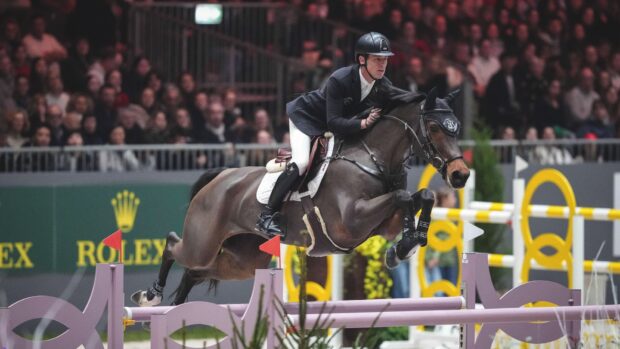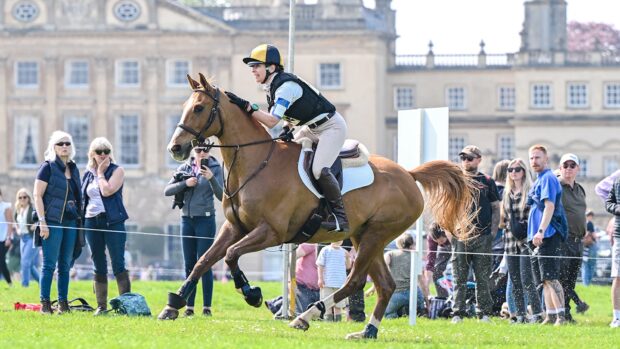Tokyo 2020 course designer Santiago Varela has set a 14-fence track for the Olympic team showjumping final tonight at the Tokyo Games.
Check out all the Olympic showjumping fences here…
Fence 1: The Great Wave off Kanagawa, Hokusai
Height: 1.55m

The Great Wave is the most recognized piece by Japanese painter Katsushika Hokusai, who specializes in ukiyo-e. Published between 1830 and 1833 during the Edo period, it forms part of the collection “Thirty-six views of Mount Fuji”, even though Mount Fuji is the smallest element. The wave references the relentless force of nature, the sea, and the importance this event has in Japan’s economy and its cultural development, given the country is formed by four islands.
The line is straight to an oxer at fence two.
Fence 2: Sakura
Front and back height: 1.53m
Spread: 1.60m
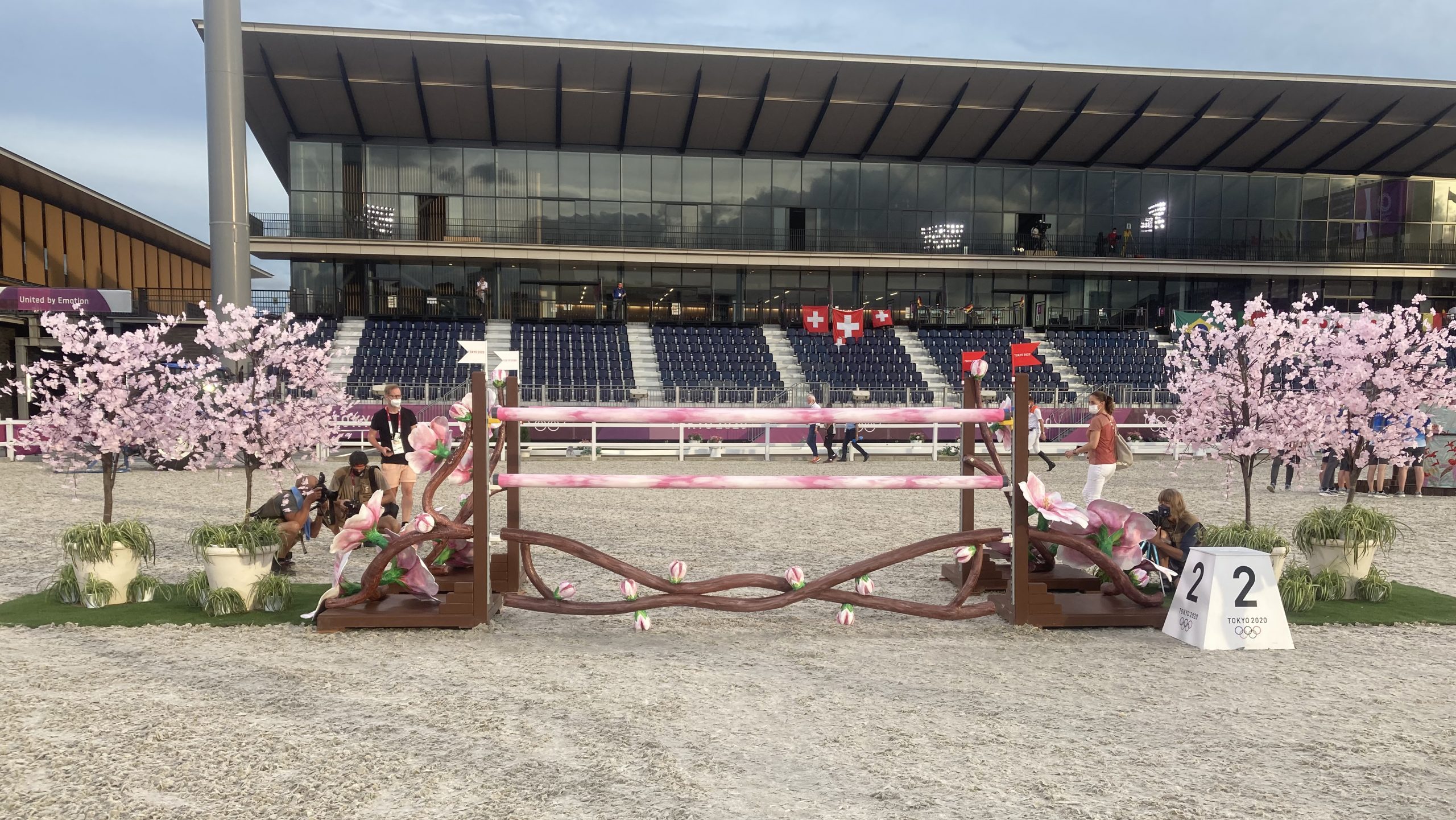
The cherry tree flower is seen as a metaphor of life, which is considered to be beautiful but at the same ephemeral. This is why it is so admired. Cherry trees (Sakura Zensen) start blooming during March in Japan, the flowering front (Kaika Zensen) moves from Okinawa towards the north of the country, ending with the flowering of the cherry trees up in Hokkaidō during the month of May. Japan’s Meteorology Office annually predict the pattern the flowering front will follow so that everybody is able to search and find which will be the optimal locations to watch the flowering of the cherry trees. This is actually really important, as the cherry tree flower only lasts for one week, something that matches really well with the traditional Japanese spirit and ideology based upon the shortness and continuous movement of life.
After fence two, riders curve right-handed round to the two-stride double at fence three.
Fence 3ab: Kokeshi Dolls
Fence 3a front and back height: 1.53m; spread: 1.65m
Fence 3b height: 1.61m
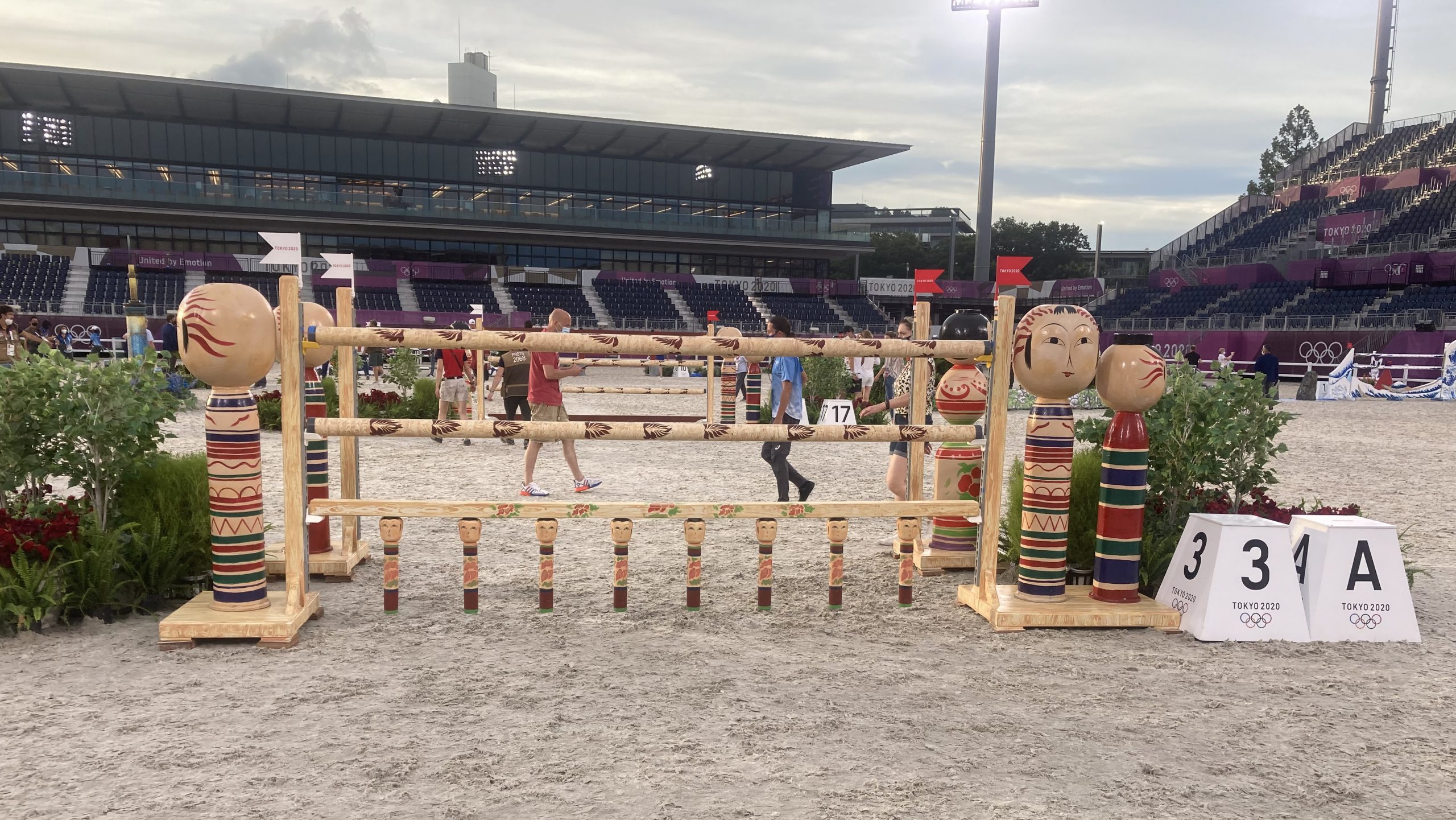
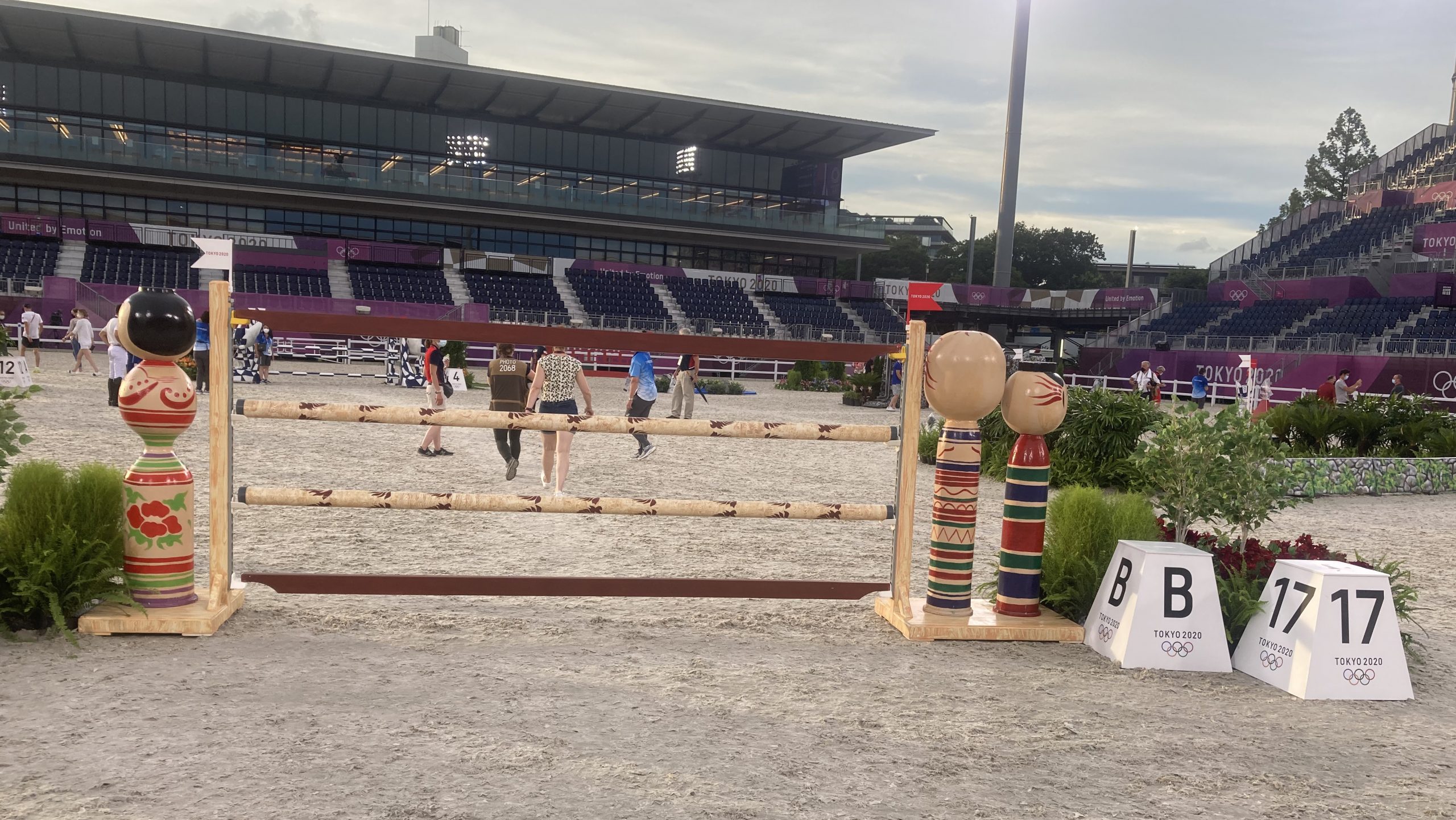
The Kokeshi are traditional Japanese dolls. Originally crafted in Tokohu, a region in the north of Japan, an area most commonly known for its spas and thermal waters. Those considered to be the most traditional are called Naruko, and they are crafted in Miyagi. Its origin dates back to the 17th century, halfway through the Edo period. They are handmade and crafted in wood from either the dark cherry or the lighter mizuki tree. The original kokeshi dolls were crafted following a simple design and had an elongated shape mixed with subtle colours. As years have passed, more designs have appeared, always keeping one main characteristic in common, the lack of arms and legs. The body is usually decorated with floral motifs or with the appearance of a kimono, despite this, there are many different kinds, with different sizes and patterns. They are considered to be both decorative and good luck amulets. As the wood with which they are carved, the Mizuki, has a high resistance to fire, they are often bought to protect the house from fires. There are two types of kokeshi, traditional and creative or “Sosaku”. The latter are relatively new, often so extraordinary in their expression that they have a high artistic value.
Riders continue on a slight left band to fence four.
Fence 4: Mascot of the Tokyo 2020 Olympics
Front and back height: 1.55m
Spread: 1.65m

Manga and gamer references are seen, in representation of the Japanese contemporary visual culture and with a character design inspired by the Tokyo 2020 Olympic Games’ logo. The pair of futuristic characters combine tradition and innovation. The name of the Olympics mascot, Miraitowa, fuses the Japanese words for future and eternity. Someity, the Paralympics mascot, is derived from Somei-yoshino, a type of cherry blossom, cherry blossom variety “Someiyoshino” and is a play on words with the English phrase “So mighty”. The two mascot designs were selected by elementary schoolchildren across Japan. Tokyo 2020 organizing committee president Yoshiro Mori said at the ceremony: “These mascots are your friends, you have helped to pick them, and across the country, … five million children helped to pick this. And the name is also something we have picked together. So, this Olympics belongs to everyone.”
After fence four, the competitors will turn left-handed back to the trible bar at fence five.
Fence 5: Tanabata Festival, Miyagi
Front height: 0.85m
Back height: 1.60m
Spread: 1.90m

During the Tanabata festival, the three most important celebrations are considered to be: Sendai Tanabata Matsuri, which takes place at the Miyagi prefecture; Shōhan Hiratsuka Tanabata Matsuri, which takes place at the Kanagawa prefecture and lastly, the Anjō Tanabata Matsuri, which takes place at the Aichi prefecture. Tanabata is a national holiday in Japan, it’s considered one of their five traditional festivals, or gosekku (a fusion of Chinese and Japanese culture). Every year, on the seventh day of the seventh month of the lunar calendar (for some regions it is 7 July, for others, 7 August), Japanese people celebrate the annual encounter between Orihime (Vega) also known as the Weaver Girl and the mother of silk farming; and Hikoboshi (Altair) also known as the Cow Herder Star and the farmers’ messenger. The tradition states that once both meet they set up on a trip where they travel through the Milky Way to renew their love vows. Sendai’s (Miyagi) celebration is one of the most popular, and it is celebrated during the month of August. In Japan, this trip is commemorated by decorating trees with paper strips where people write their wishes, they are also known as tanzaku bands. Once written they are usually strapped up on bamboo branches, due to their stiffness which keeps them up straight without bending. According to the tradition, this helps the branches’ whisper reach the sky, and with it, everybody’s dreams.
The riders continue straight ahead to the treble combination.
Fence 6abc: Nature, Landscape and Animals
Fence 6a height: 1.58m
Fence 6b front and back height: 1.53m; spread: 1.60m
Fence 6c height: 1.60m
There is one stride between each jumping element.
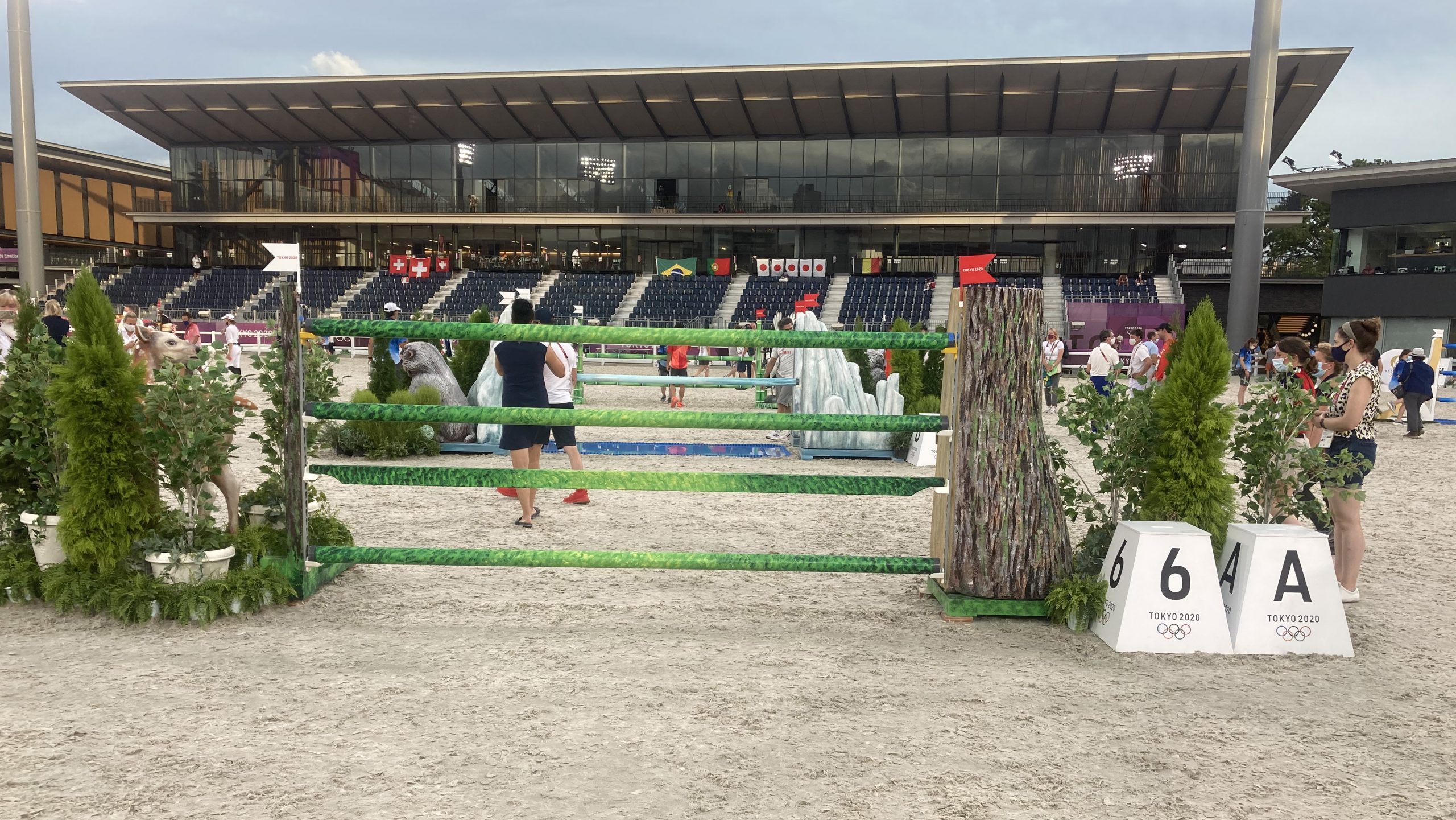


Outside of mythology, certain animals are considered national treasures of Japanese culture. The Japanese deer were considered sacred animals because of their relationship with gods of the Shinto pantheon. The two most important Japanese deer colonies are found today in the parks of Nara and on the island of Miyajima, next to Hiroshima. El Japanese Macaque, (Nihonzaru), is native to Japan and lives in the natural park of Nagano, particularly in the Jigokudani Yaen Koen. This forest full of springs of Oonsen thermal waters (温泉おんせん) is the primate that lives further north than any other non-human primate, supports the strong Japanese winters. The crane, bird venerated throughout all of Japan, stands out for its elegance, longevity and the aura of spirituality that surrounds it. Its agility and his strong reaction to the danger have been inspiration for hundreds of years in the martial arts. We can find it distributed along the island of Hokkaido, located in the north of Japan.
There is a right-hand turn after the treble, doubling right back round to the wall at fence seven.
Fence 7: The Nikko Mausoleum, Tochigi
Height: 1.61m
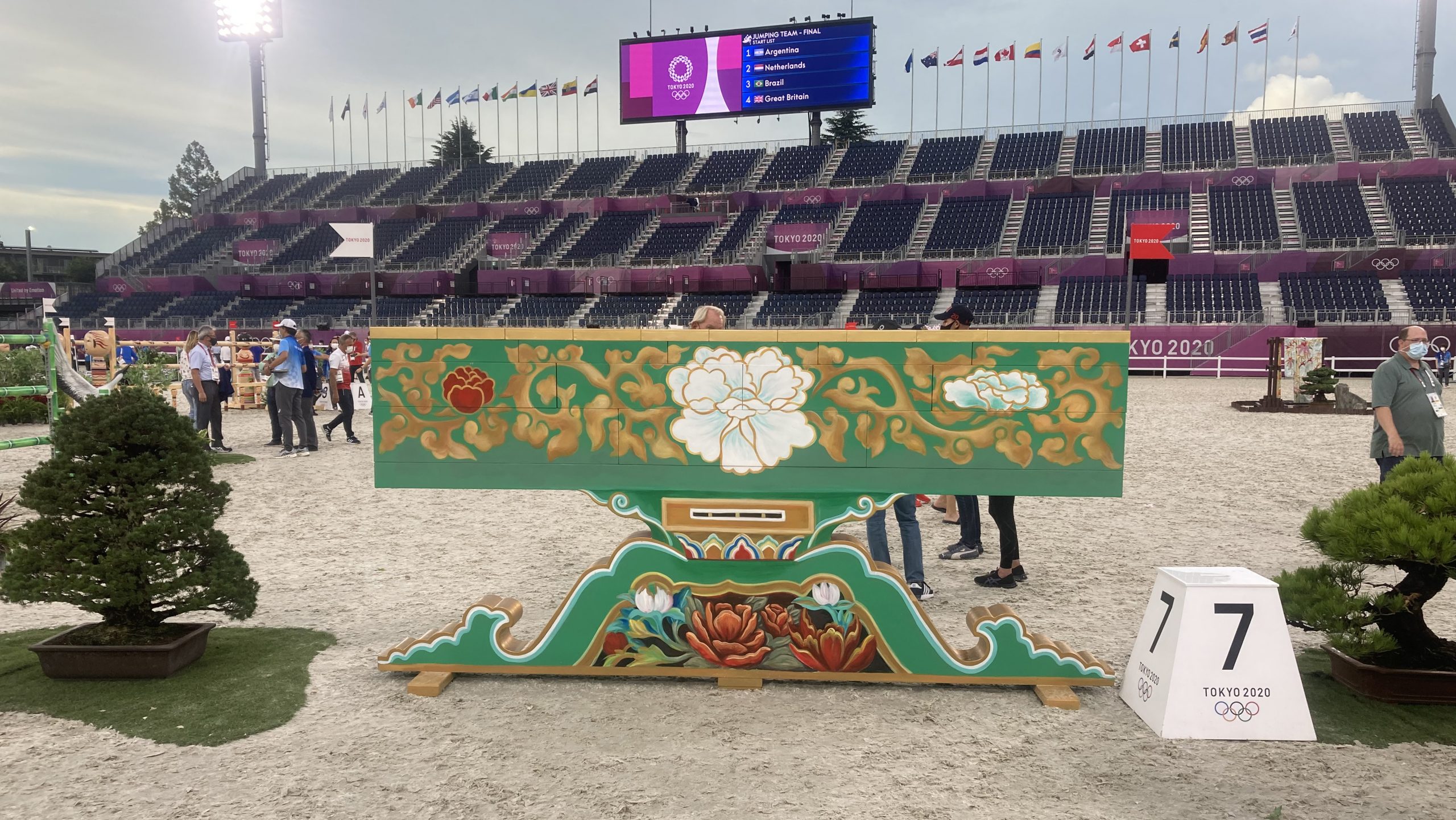
The Shrines and Temples of Nikko form a single complex composed of one hundred three religious’ buildings within two Shinto shrines (The Tôshôgû and The Futarasan-jinja) and one Buddhist temple (The Rinnô-ji) located in an outstanding natural setting. The inscribed property is located inside the Tochigi Prefecture, in the northern part of Japan’s Kanto region. The mausoleum has been designated a National Treasure and UNESCO World Heritage Site in 1993. These buildings were constructed in the 17th century on the mountain slopes so as to create different visual effects. Within the ensemble Nikkō Tosho-gū there is a Shinto shrine, which was built by Tokugawa Leyasu’s grandson so that his spirit could rest. The sanctuary is accessed through a stone torii. After leaving the five-storey pagoda behind, you can access to the enclosure. Through the luxurious Yomeimon gate you can reach the Karamon gate behind which, is the Haiden prayer hall and the main hall Honden, the sanctuary’s neuralgic centre. To the right of the main hall, is the Sakashitamon door, where you will find the wood carving of the Nemurineko or “sleeping cat”.
There are four straight strides from fence seven to fence eight.
Fence 8: Kimonos
Front and back height: 1.53m
Spread: 1.60m

The Japanese kimono is one of the world’s instantly recognizable traditional garments. The word kimono literally means “clothing”, and up until the mid 19th century it was the form of dress worn by everyone in Japan. This began to change slowly with the import of suits, dresses and other western fashions. Thanks to the popularity of ukiyo-e woodblock prints in the West at the beginning of the past century, the kimono-clad maiden became one of the quintessential images of Japan. Dressing up in the kimono and other accoutrements of the geisha or maiko is still one of the more popular activities for visiting tourists. There are different types of kimono for different occasions and seasons, including those worn by men. Other than those worn daily by some older people or performers of traditional arts, kimono is a much less common sight these days but are still widely worn on special occasions such as weddings and graduation ceremonies. Lined kimono, is traditionally made out of silk but sometimes wool or synthetic fabrics, are worn during the cooler months. Light, cotton yukata is worn by men and women during the summer months and after bathing at onsen (hot spring resorts) and ryokan (traditional inns). Often, they are worn with geta, informal wooden footwear.
After the oxer, riders turn left to the open water jump.
Fence 9: Stone Bridge, Shikinaen Garden, Ryukyu Islands
Spread: 4m
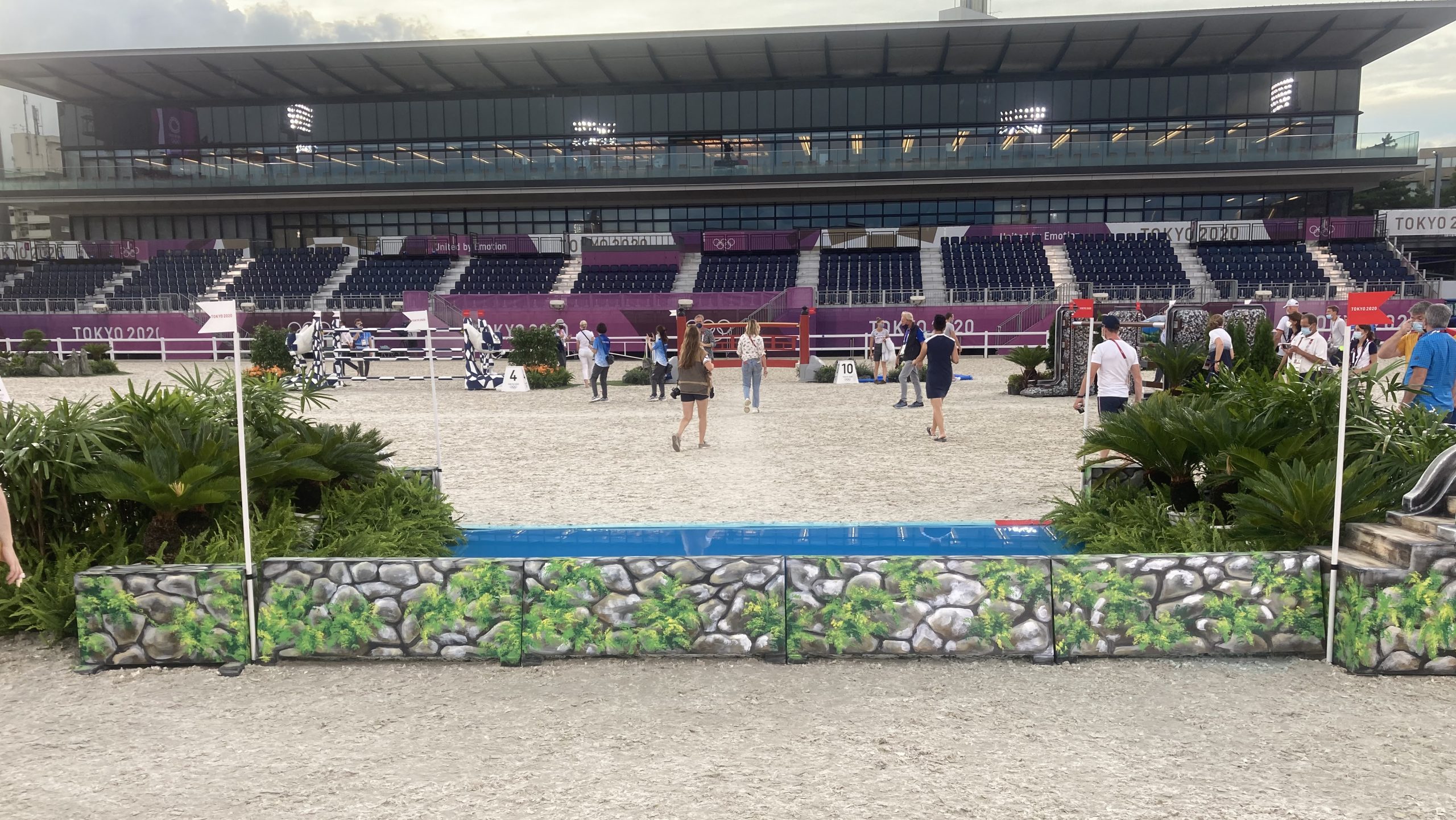

Shikinaen (識名園) was constructed in the end of the 18th century as the second residence for the Ryukyu kings. Its features are beautiful, relatively simple, wooden palace buildings in Okinawan style, red tile roofs and a spacious Japanese style landscape garden with a central pond. While the garden is designed in a style seen elsewhere in Japan, the architecture and flora give Shikinaen a uniquely Okinawan flavour. In 2000, Shikinaen was among those which were added to the list of UNESCO World Heritage Sites under the title Gusuku Sites and Related Properties of the Kingdom of Ryukyu. The garden can be viewed from a 300-metre circular path, which leads through a forested area before reaching the pond. Two stone bridges connect to a small islet in the middle of the water and allow visitors to cross from one side of the pond to the other. A small hexagonal pavilion stands on a second islet. Artificial hills surround the pond and give the garden more vantage points and character.
There are five strides after the water to the upright planks at fence 10.
Fence 10: Shinkyo Bridge
Height: 1.63m

Nikko Bridge Shinkyo (神橋, Shinkyō) is located at the entrance before reaching the temple and shrines area of Nikko, surrounded by spectacular nature. It belongs to the beautiful and ancient Futarasan Shrine (二荒山神社). This bridge is listed as one of the three most beautiful bridges in Japan next to the Kintaikyo Bridge of Iwakuni and the Saruhashi of Yamanashi prefecture. The Shinkyo bridge that can be seen at present was built in the year 1636, but until 1973 was not open to the public.
After fence 10, competitors turn right-handed and double back round to the oxer at fence 11.
Fence 11: Hachiko
Front and back height: 1.55m; spread: 1.60m

Since 1924, Hidesaburo Ueno, professor at the University of Tokyo, and his puppy Akita, breed of the ancient guardians of the Emperors, became inseparable. Every day they walked to the Shibuya train station located in the centre of Tokyo where the dog waited for him until his return so that they could walk their way back home together. This routine lasted two years, until Ueno died of a cerebral haemorrhage while he was in class. His wife donated Hachi to a new family, but he continued to wait for his former owner at the train station for 10 years. They began to publish Hachi’s stories in local newspapers, and in 1934 a statue was erected in front of the Shibuya train station, with Hachi as the main guest at its inauguration. A year later, in 1935, Hachiko died at the station, and was buried next to his owner at the Aoyama Cemetery in Tokyo. This story was taken to the cinema in 1987 by the Japanese filmmaker Seijiro Kojama; the film, in black and white, is titled Hachiko Monogatari (The story of Hachiko). In 2009 a remake was made in the United States directed by Lasse Hallström under the title “Hachi: A Dog’s Tale”.
It’s six strides from fence 11 to the double at fence 12.
Fence 12ab: Japanese Fan
Fence 12a height: 1.58m
Fence 12b front and back height: 1.54m; spread: 1.65m
There is one stride between the two elements.
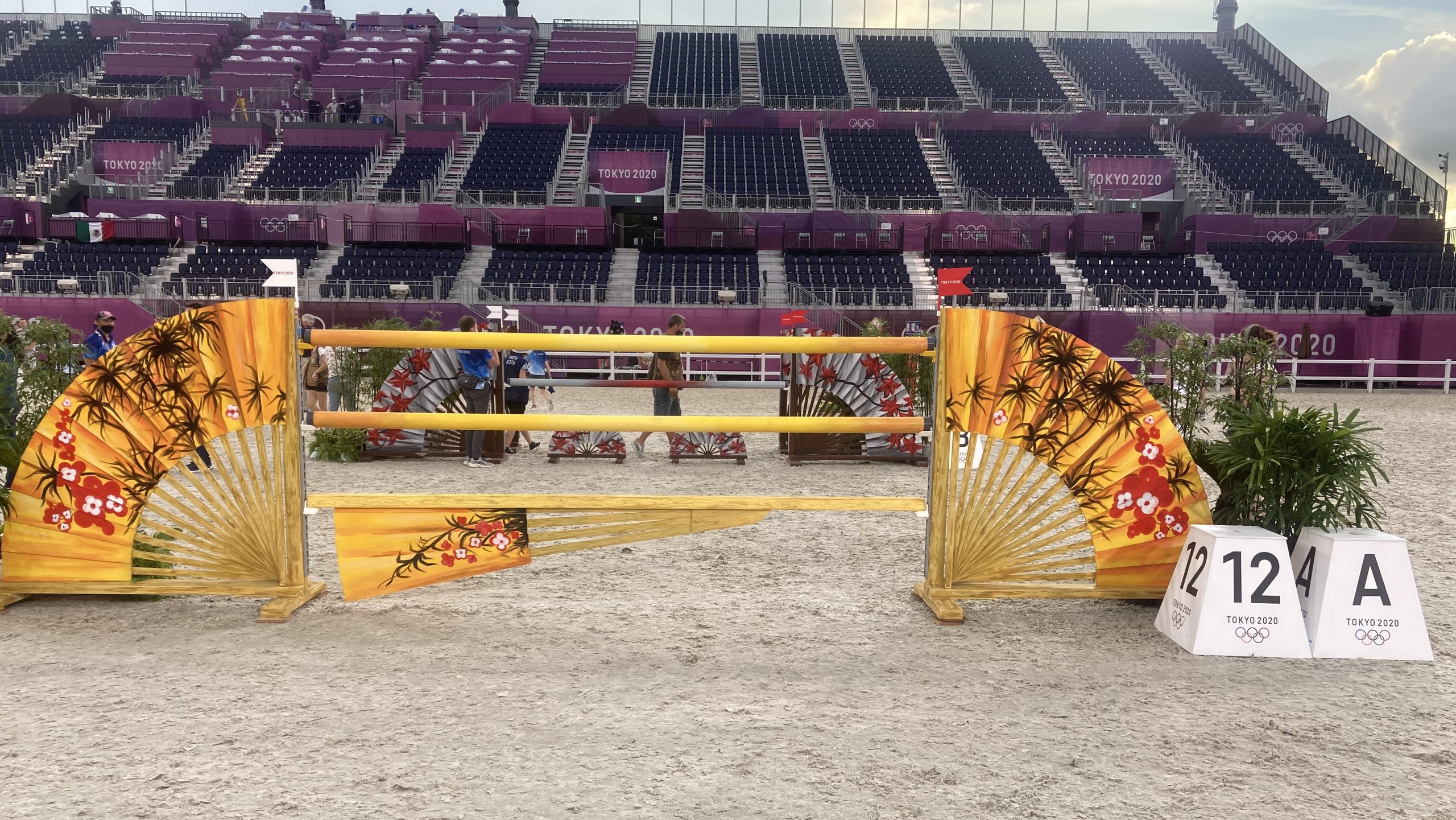

Since its arrival during the 6th century within the upper classes of the imperial court, and with the sole objective of keeping the heat away, the Japanese fan (ôgi, generic; sensu, 扇子, folding) has been considered really important inside Japanese culture. This kind of fan was also the instrument used by the Samurai to send signals when they were on the battlefield; it was also used by judges, kabuki actors, dancers and geishas. The fan itself is a symbol of prosperity as it extends when we open it. For the Japanese, the fan starts from a single point, the Clavillo, considered our birth, and the strips of wood, which extend in various directions, are in Japan the different roads life can take.
Riders then take a left turn to the final line of two fences.
Fence 13: Japanese Calligraphy
Fence 13 front and back spread: 1.55m; spread: 1.70m

Shodo 書道, “The trail of Japanese writing”, is the art of Japanese calligraphy. Japanese inherited their calligraphy tradition from a millenary Chinese tradition, which was introduced by Japanese Buddhist monks. Nowadays Japanese calligraphy is considered an art, and it is practiced making use of traditional tools which have been inherited from the Chinese tradition.
There are then four strides down to the final fence.
Fence 14: Paris 2024
Height: 1.65m
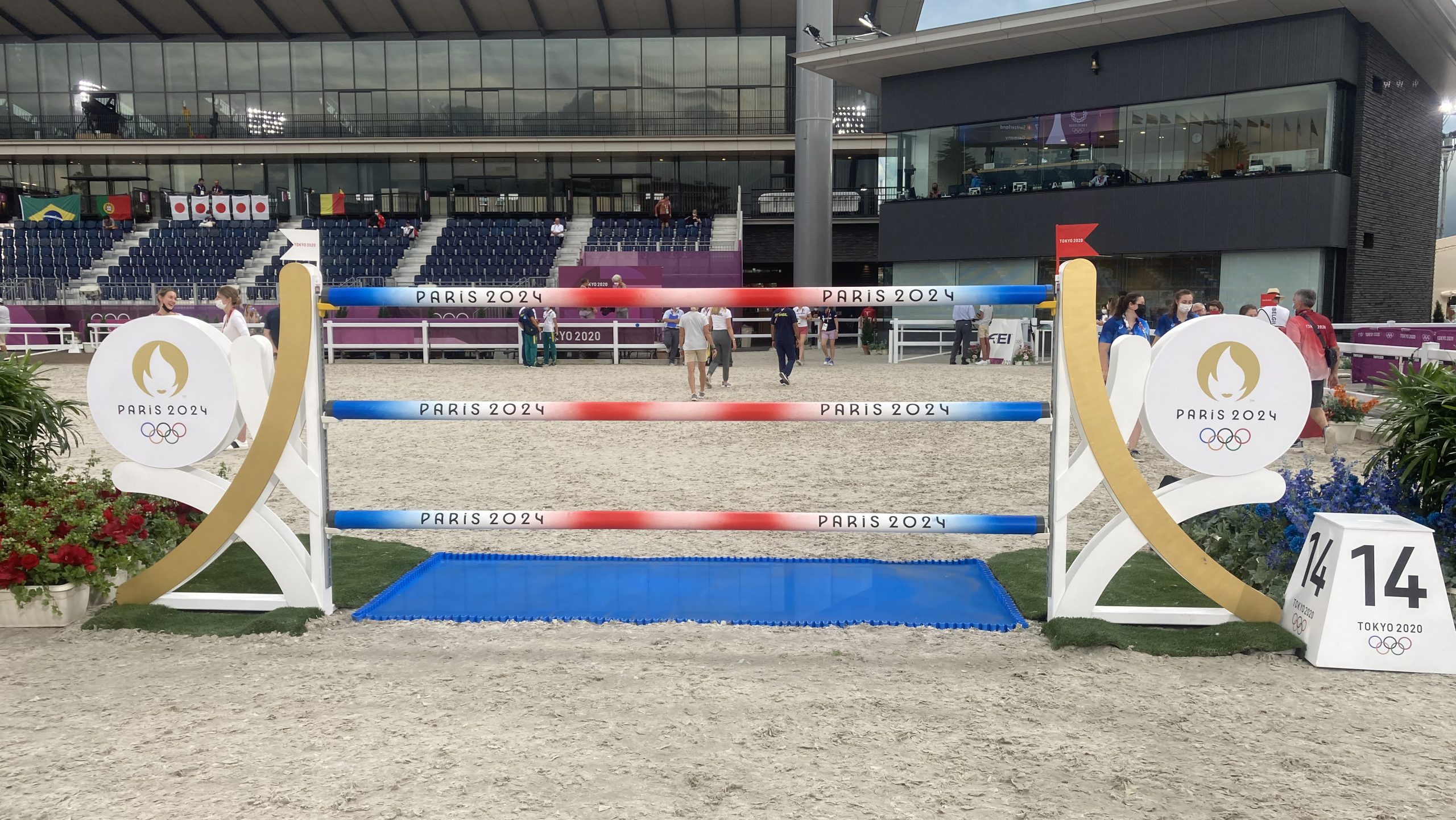
The final fence marks handing the Olympic baton over to Paris for the 2024 Games.
Olympic team showjumping final course plan

You might also be interested in:

Starting order released for Olympic team showjumping final – find out when the Brits jump for the last medals of the Games

How to watch Olympic showjumping live

Which nations have qualified for the Olympic jumping team final? Here’s how they did it and what the riders said…

‘We’ll come out fighting tomorrow’: Britain secures place in Olympic team showjumping final

Subscribe to Horse & Hound magazine today – and enjoy unlimited website access all year round
Horse & Hound magazine, out every Thursday, is packed with all the latest news and reports, as well as interviews, specials, nostalgia, vet and training advice. Find how you can enjoy the magazine delivered to your door every week, plus options to upgrade your subscription to access our online service that brings you breaking news and reports as well as other benefits.


